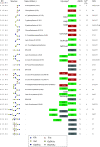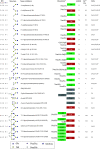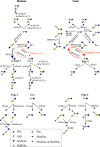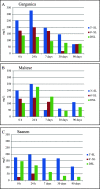Goat Milk Oligosaccharides: Their Diversity, Quantity, and Functional Properties in Comparison to Human Milk Oligosaccharides
- PMID: 33141570
- PMCID: PMC7705968
- DOI: 10.1021/acs.jafc.0c03766
Goat Milk Oligosaccharides: Their Diversity, Quantity, and Functional Properties in Comparison to Human Milk Oligosaccharides
Abstract
Human milk is considered the golden standard in infant nutrition. Free oligosaccharides in human milk provide important health benefits. These oligosaccharides function as prebiotics, immune modulators, and pathogen inhibitors and were found to improve barrier function in the gut. Infant formulas nowadays often contain prebiotics but lack the specific functions of human milk oligosaccharides (hMOS). Milk from domesticated animals also contains milk oligosaccharides but at much lower levels and with less diversity. Goat milk contains significantly more oligosaccharides (gMOS) than bovine (bMOS) or sheep (sMOS) milk and also has a larger diversity of structures. This review summarizes structural studies, revealing a diversity of up to 77 annotated gMOS structures with almost 40 structures fully characterized. Quantitative studies of goat milk oligosaccharides range from 60 to 350 mg/L in mature milk and from 200 to 650 mg/L in colostrum. These levels are clearly lower than in human milk (5-20 g/L) but higher than in other domesticated dairy animals, e.g., bovine (30-60 mg/L) and sheep (20-40 mg/L). Finally, the review focuses on demonstrated and potential functionalities of gMOS. Some studies have shown anti-inflammatory effects of mixtures enriched in gMOS. Goat MOS also display prebiotic potential, particularly in stimulating growth of bifidobacteria preferentially. Although functional studies of gMOS are still limited, several structures are also found in human milk and have known functions as immune modulators and pathogen inhibitors. In conclusion, goat milk constitutes a promising alternative source for milk oligosaccharides, which can be used in infant formula.
Keywords: goat milk oligosaccharides; health benefits; prebiotics; quantitative analysis; structures.
Conflict of interest statement
The authors declare the following competing financial interest(s): Eric Benjamins and Alfred Haandrikman are employed by Ausnutria BV. Evelien M. te Poele, Anastasia Chrysovalantou Chatziioannou, and Lubbert Dijkhuizen are employed by CarbExplore Research BV, which has received financial support from Ausnutria BV, at least partly used to fund the work of Sander S. van Leeuwen.
Figures







References
-
- Meredith-Dennis L.; Xu G.; Goonatilleke E.; Lebrilla C. B.; Underwood M. A.; Smilowitz J. T. Composition and Variation of Macronutrients, Immune Proteins, and Human Milk Oligosaccharides in Human Milk From Nonprofit and Commercial Milk Banks. J. Hum. Lact. 2018, 34 (1), 120–129. 10.1177/0890334417710635. - DOI - PubMed
-
- Kondyli E.; Svarnas C.; Samelis J.; Katsiari M. C. Chemical Composition and Microbiological Quality of Ewe and Goat Milk of Native Greek Breeds. Small Rumin. Res. 2012, 103 (2–3), 194–199. 10.1016/j.smallrumres.2011.09.043. - DOI
-
- Park Y. W.Goat Milk—Chemistry and Nutrition. In Handbook of Milk of Non-bovine Mammals; Park Y. W., Haenlein G. F. W., Wendorff W. L., Eds.; John Wiley & Sons, Ltd.: Oxford, U.K., 2017; Chapter 2.2, pp 42–83,10.1002/9781119110316.ch2.2. - DOI
Publication types
MeSH terms
Substances
LinkOut - more resources
Full Text Sources
Other Literature Sources

